Discover the Vibrant World of Ubud Paintings in Bali
Finding Ubud Paintings in Ubud, Bali, is a breeze as they are readily available in various locations. You can explore local art galleries, markets, and shops showcasing these captivating artworks. For a diverse selection at affordable prices, don’t miss the Ubud Art Market. Additionally, it’s advisable to visit recommended galleries, where you’ll find high-quality paintings crafted by master artists, often accompanied by certificates authenticating their originality.
Ubud Painting, along with other distinctive painting styles from Batuan, Kamasan, and Pengosekan, reflects not only the natural beauty of Bali but also its rich culture and traditions. Bali’s reputation on the international stage is significantly influenced by its vibrant Balinese art scene. When people visit Bali, they are drawn to the enchanting Balinese dances and the exquisite craftsmanship encompassing wood carving, batik, silversmithing, and, of course, art painting.
Ubud Painting stands as one of the most renowned artistic expressions exclusively associated with Ubud, Bali. The evolution of Ubud Art Painting has been marked by a fusion of traditional elements with contemporary styles, fostering a captivating blend of tradition and modernity. This evolution was kickstarted by the arrival of renowned painters from beyond Bali’s shores, who injected fresh perspectives into the art while preserving its innate character. Bali’s unique blend of culture, traditions, and natural beauty continues to attract artists from around the world, enticing them to not only create but also reside in this remarkable island paradise.

Ubud Painting: A Fusion of Influence and Evolution
Ubud painting bears the profound influence of the Kamasan-style painting, one of the earliest artistic traditions to emerge in Bali. This influence is deeply ingrained across the island, notably adorning the walls of sacred shrine structures. In contrast to the less pervasive Batuan style, it’s worth noting that Batuan-style painting requires a higher level of skill and intense concentration, resulting in a lengthier process for even the smallest artwork. It’s intriguing to observe that despite its roots in Batuan, the Batuan painting style found its own distinct path of development in Ubud, a village situated about 10 kilometers away.
Initially, the Ubud style closely resembled the Batuan style, predominantly centered on themes of faith and religion, drawing inspiration from the narratives of the Ramayana, Mahabharata, and Hindu ritual artifacts. The palette, too, mirrored the use of black and white blends. Though these paintings lacked a three-dimensional aspect, they were intricately detailed, resembling leaves on a tree meticulously crafted by the artist, leaving no detail untouched.
However, the introduction of Dutch painters like Walter Spies in 1926 and Rudolf Bonnet in 1928 marked a transformative period for Ubud painting. Their arrival ushered in the adoption of three-dimensional techniques, revolutionizing the face of Ubud painting and opening up new dimensions of artistic expression.
Art Painting Museums in Ubud

Museum Puri Lukisan Ubud
In Ubud, Bali, Museum Puri Lukisan houses a captivating collection of Balinese art, both traditional and contemporary. Located on Jalan Raya Ubud, it’s a must-visit cultural destination. Explore the rich artistic heritage of Bali amidst lush surroundings.
ARMA (Agung Rai Museum of Art) – Ubud
In Ubud, Bali, ARMA (Agung Rai Museum of Art) is a cultural gem celebrating Indonesian and Balinese art. It’s located on Jalan Raya Pengosekan and offers a rich artistic experience in a beautiful setting.
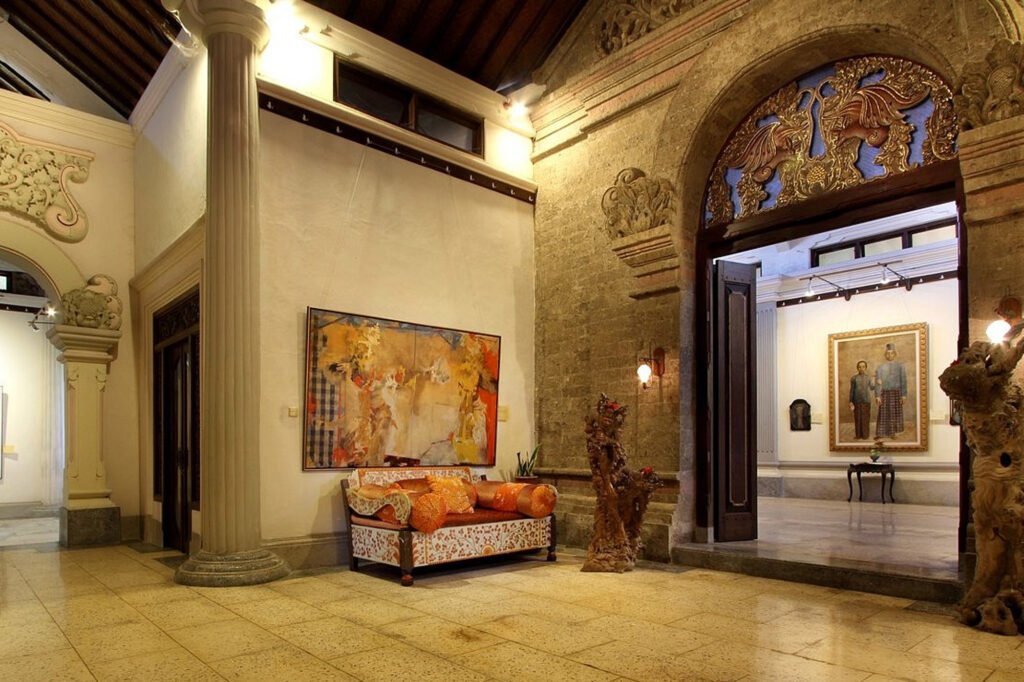
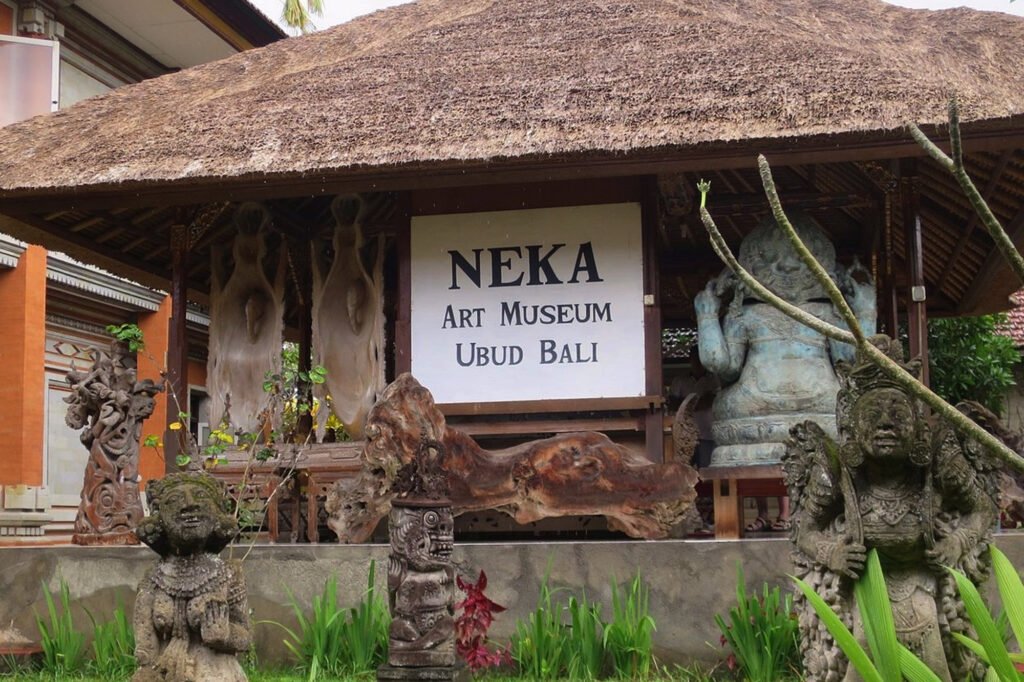
Neka Art Museum Ubud
Neka Art Museum in Ubud, Bali, showcases Indonesian art, including traditional and contemporary Balinese works. Located on Jalan Raya Sanggingan, it’s a must-visit for art and culture enthusiasts.
The Blanco Renaissance Museum Ubud
Discover the artistry of Antonio Blanco at this museum in Ubud, Bali. Located on Campuhan Ridge, it’s a unique blend of art and nature. Explore Blanco’s vibrant creations in a scenic setting.

Captivating Balinese Art Painting Styles
The Artistry of Ubud Painting Style
- Rooted in Tradition: Ubud’s painting style proudly carries the hallmarks of classical and traditional Balinese aesthetics.
- Eco-Conscious Creation: Artists in Ubud typically employ organic paints and natural materials, demonstrating their commitment to eco-friendly practices in the art-making process.
- Nature’s Influence: Ubud paintings frequently feature motifs inspired by the lush natural landscapes of Bali, showcasing scenes of rice fields, vibrant flowers, and narratives rooted in Balinese culture.
- Exquisite Craftsmanship: Ubud paintings are known for their meticulous attention to detail, emphasizing the high quality and precision of the artwork.
- Mythical Inspirations: Drawing from the rich tapestry of Balinese mythology, legends, and traditional tales, Ubud artists infuse their creations with captivating narratives and cultural significance.
Exploring the Pengosekan Painting Style
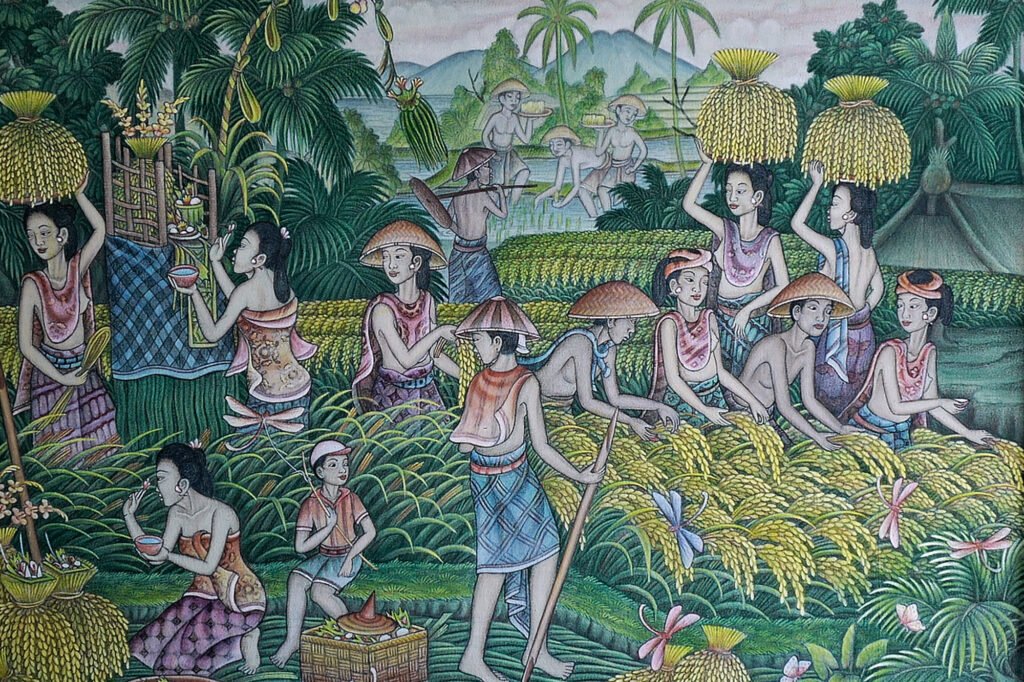
- A Modern Artistic Expression: The Pengosekan painting style leans towards modernity, placing a strong emphasis on self-expression.
- Vivid Colors and Striking Accents: Pengosekan paintings are characterized by their vibrant, contrasting colors and eye-catching accents.
- Realism in Focus: Themes in Pengosekan paintings often revolve around the portrayal of realistic scenes, capturing the essence of daily life, traditional dances, and Balinese activities.
- Contemporary Flair: Occasionally, Pengosekan art may incorporate contemporary elements or artistic styles from beyond Bali, lending it a touch of the contemporary art world.
- Freedom and Experimentation: This painting style grants artists the liberty to freely express their emotions and imagination, fostering a sense of artistic freedom and experimentation.
Kamasan Painting Style
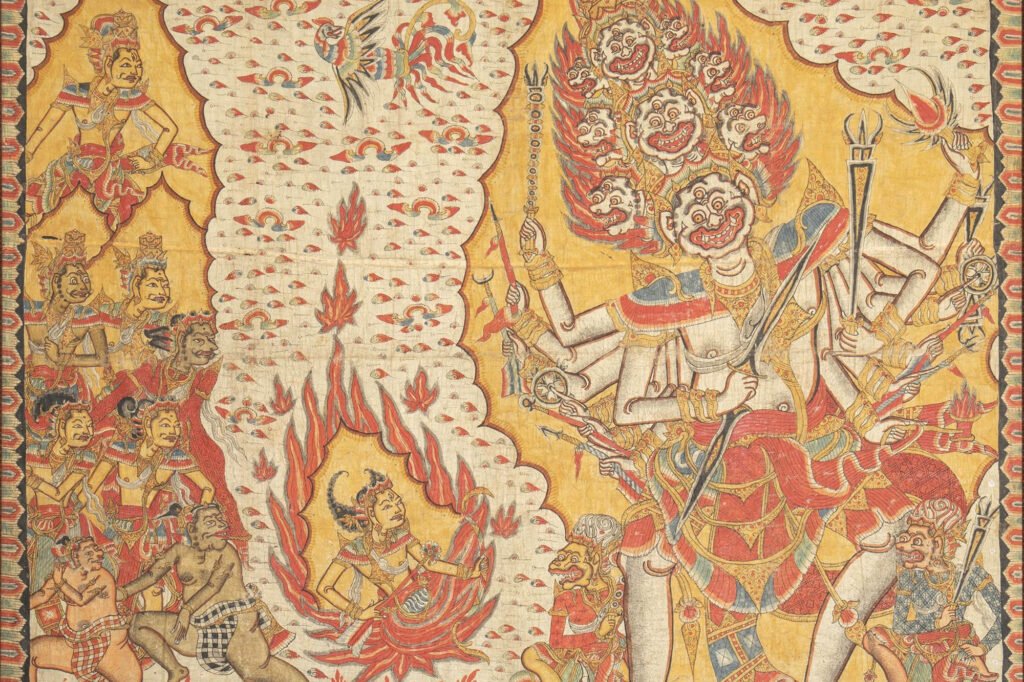
Kamasan painting, a classic Balinese art, is easily recognizable by its light brown hue from limestone (“Batu gamping”) mixed with water and intricate black lines. Watercolors add vibrancy.
Rooted in ancient traditions, it holds philosophical, spiritual, and cultural significance. These paintings serve as ritual objects, conveying moral tales, and align with Hindu teachings about sacred spaces.
Themes feature wayang characters from epics like the Ramayana and Mahabharata. Collectors admire Kamasan style for its refinement, clarity, and sophistication in storytelling.
Batuan Painting Style

The Batuan painting style is characterized by its distinctive features, notably the absence of perspective and the ability to incorporate multiple themes seamlessly.
This style is marked by its solid and densely filled compositions, leaving little to no empty space. Perspective remains consistent throughout the painting, whether viewed from above or below.
Furthermore, Batuan painting employs five distinct techniques:
- Sketching (Nyawi): This technique involves drawing to refine pencil lines.
- Nguntur: Used to differentiate objects in terms of their proximity.
- Sigar: Employed to segment the lines within the painting.
- Motifs: Incorporating patterns like batik, bricks, and intricately carved temples.
- Coloring: The final step that adds vibrant hues to the artwork.
Notably, the process of creating Batuan paintings is time-intensive, often spanning from one to nine months to complete a single piece.
Ubud Painting and the Western Artists
In the 1920s, Bali saw the arrival of renowned Western painters who left an indelible mark on the artistic landscape. Figures like Walter Spies, Rudolf Bonnet, Jose Miguel Covarrubias, Don Antonio Blanco, Adrien Jean Le Mayeur, and Arie Wilhelmus Smith not only chose to make Bali their home but also formed lasting connections, including marriages with Balinese women.
This cultural fusion gave rise to the increasing fame of Ubud paintings, with Western artists collaborating closely with esteemed local Balinese artists.
Walter Spies
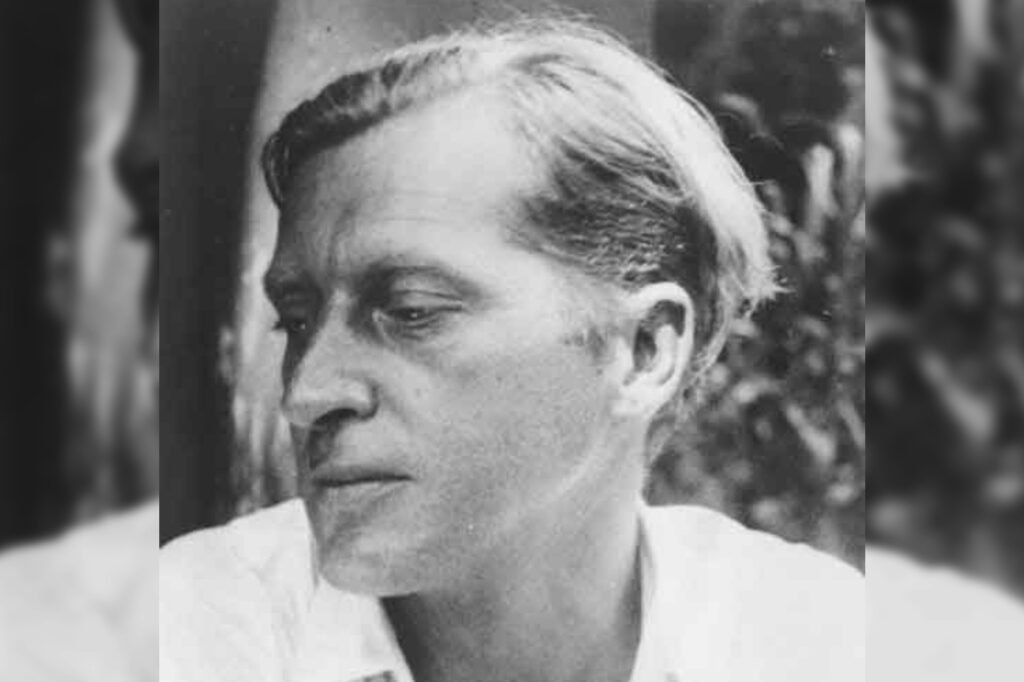
Walter Spies, a German painter, made the transformative move to Bali in 1923. His artistic focus frequently gravitated towards the picturesque rice fields of Ubud. In his works, he masterfully captured the essence of community life within the rice fields, employing a primitivist painting style that resonated deeply with the traditional Balinese way of life.
Rudolf Bonnet

Dutch painter Rudolf Bonnet arrived in Bali in 1929, where he lived and established his studio in Campuan. His art primarily consists of expressive, naturalistic portraits of Balinese people. His contributions extend to the Museum Puri Lukisan, where his designs and works, along with those of Cokorda Gede Agung Sukawati, are showcased.
Jose Miguel Covarrubias

In 1933, Mexican artist Jose Miguel Covarrubias found inspiration in Bali. He painted scenes of Balinese women in rural settings, showcasing their unique culture, including their traditional attire. His art also celebrated the Legong dances performed by women.
Don Antonio Blanco

Arriving in Bali in 1952, Don Antonio Blanco, originally from Manila, Philippines, married a Balinese dancer named Ni Ronji. His paintings often feature explicit depictions of Balinese women, celebrating their enduring femininity with an expressive and dreamy romantic style.
Beyond this, he captured the essence of Bali through landscapes, its environment, love, and the pervasive artistry of the island. Don Antonio Blanco devoted his life to Bali and established the Blanco Museum, known as the “Blanco Musium.”
Adrien Jean Le Mayeur

Adrien Jean Le Mayeur arrived in Bali in 1932, making Sanur his home. He married Ni Nyoman Pollok, a legong dancer who often served as his muse. His paintings beautifully reflect the Balinese way of life, the rich tapestry of Balinese Hindu culture, local rituals, religious sites, and traditional dances.
Le Mayeur’s art celebrated the island’s abundant natural beauty, light, and vivid colors. He portrayed this enchanting world through his naturalistic acrylic paintings.
Arie Wilhelmus Smit

Arie Wilhelmus Smit arrived in Bali in 1956, sparking a lifelong connection. He’s known for nurturing young talent in his studio, and his ‘young artist’ style. In 1994, he founded the Neka Art Museum, displaying his work and that of contemporary Balinese artists. His art has graced exhibitions in Jakarta, Singapore, Honolulu, and Tokyo, and a 2016 monograph titled “A Painter’s Life in The Tropics” captures his artistic journey. Smit is among the many foreign artists who have made Bali an art hub, attracting art enthusiasts to the “Island of the Gods.”
Unveiling the Artistry of Ubud
Come explore the enchanting world of Ubud’s artistry! Delve into the creative process as artists wield their brushes to craft captivating paintings that weave tales of beauty and wonder. It’s akin to entering a hidden realm where colors and shapes harmoniously spring to life, inviting you to be part of the magic.
Exploring Traditional Balinese Art
Picture vibrant artworks that narrate age-old tales – that’s the enchantment of traditional Balinese art! Come join us in discovering these captivating creations, steeped in centuries of history and culture.
Elevate Your Home with Art
Looking to make your home unique? Let’s discuss the world of paintings! We’ll guide you in selecting artwork that enhances your space, bringing both warmth and style to your abode.
Discovering Ubud’s Artistic Treasures
Embark on an artistic journey through Ubud, where we’ll unveil a diverse array of captivating paintings created by talented artists. Get ready for delightful surprises and moments of sheer excitement!

Get Your Own Unique Painting
Ever dreamed of owning a piece of art? Let us assist you in finding an authentic painting from Ubud, providing you with something truly one-of-a-kind to cherish forever.
Meet the Artists and Their Creations
Step into the world of talented artists who bring their ideas to life with brushes and colors. Their work will inspire you to give it a try yourself!
Join Us for Painting Fun
No need to be a pro! We’ll guide you through the enjoyable and straightforward process of creating your very own painting. It’s a fun and rewarding experience.
Exploring Diverse Art Styles
Art can take on countless forms! We’ll introduce you to a wide range of styles, from classic to cutting-edge, helping you discover what resonates with you.
Bali’s Stories Through Art
Did you know that paintings can tell stories? We’ll reveal how artists use their canvases to share tales of Bali’s rich history, its people, and timeless traditions.
Uncovering Stories in Art
Let’s listen to what these paintings have to convey. Each one harbors a unique story within, and we’ll help you decode the messages hidden in their artistry.
Discover the Cool Art of Ubud
Prepare for a captivating tour through diverse art styles! From the vintage to the contemporary, you’ll encounter a multitude of paintings that offer glimpses into Bali’s captivating world.
Recommendation Art Galleries in Ubud
Dewa Putu Toris Gallery
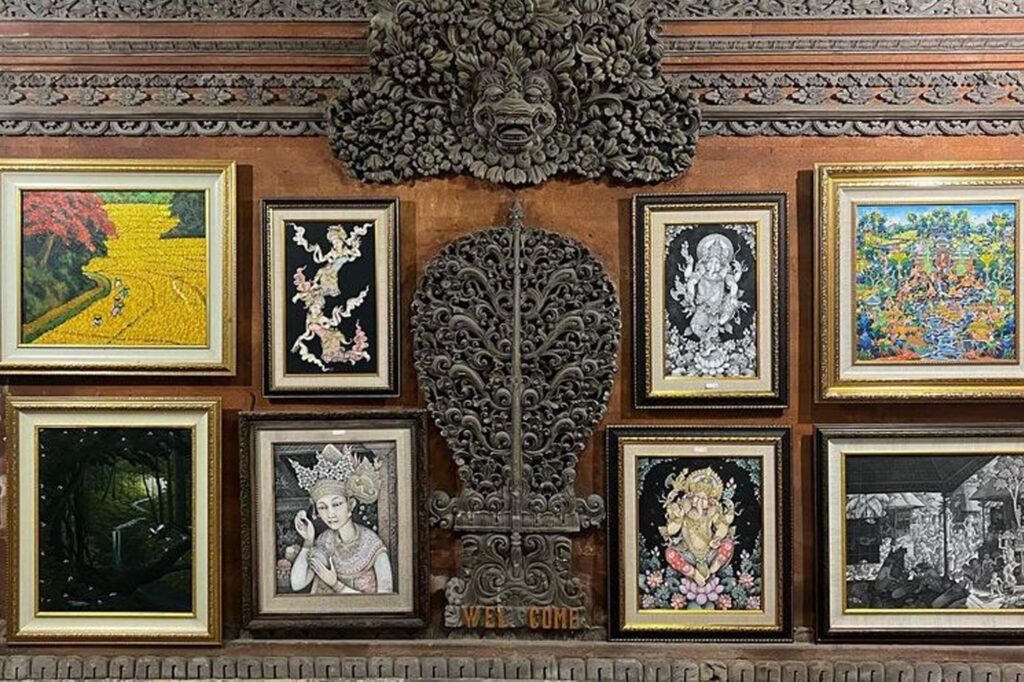
Located in Ubud, Bali, the Dewa Putu Toris Gallery pays homage to the exceptional talent of Balinese artist Dewa Putu Toris. The gallery showcases Toris’ vibrant and spiritually rich paintings, which blend traditional Balinese techniques with contemporary expressions.
Visitors can explore Toris’ artistic journey, from his early traditional works to his influential role in the 1960s Young Artists movement in Bali. This movement encouraged artistic innovation.
Although Dewa Putu Toris passed away in 2019, his legacy lives on in this gallery, offering a profound glimpse into Bali’s culture through art. It serves as a testament to his ability to blend tradition and modernity in the world of art.
Semar Kuning Art Gallery

Nestled in Ubud, Bali, the Semar Kuning Art Gallery is a cherished hub in Bali’s art scene. Here, a diverse range of Balinese and Indonesian artworks, spanning traditional to contemporary styles, takes center stage.
The gallery’s unique focus on nurturing emerging artists underscores its dynamic character. It provides an inviting space for these talents to share their perspectives with a global audience.
The serene ambiance of the Semar Kuning Art Gallery makes it an ideal destination for art enthusiasts and culture seekers. It embodies Bali’s artistic spirit and acts as a bridge between tradition and innovation in the art world. This gallery serves as a vibrant testament to Bali’s enduring artistic heritage and commitment to creative exploration.
Frequently Asked Questions (FAQ) about Ubud Art Painting
What is Ubud Art Painting?
Ubud Art Painting refers to the diverse and vibrant art created in and around Ubud, Bali. It encompasses various styles, techniques, and themes that reflect the rich cultural heritage of the region.
Where can I find Ubud Art Paintings?
Ubud Art Paintings can be found in local art galleries, markets, and shops throughout Ubud. Some well-known galleries include the Museum Puri Lukisan and ARMA (Agung Rai Museum of Art).
What are the common themes in Ubud Art Painting?
Ubud Art Paintings often feature themes inspired by Balinese culture, nature, mythology, and daily life. They may depict scenes from Hindu epics like the Ramayana and Mahabharata.
Who are the famous Ubud painters?
Famous Ubud painters include I Gusti Nyoman Lempad, Ida Bagus Made, and Dewa Putu Bedil, among others. Western artists like Walter Spies and Rudolf Bonnet also made significant contributions.
What are the painting techniques used in Ubud Art?
Ubud Art utilizes various techniques, including traditional Balinese methods like Kamasan and Batuan styles. These techniques involve intricate details and bold colors.
Are Ubud Art Paintings influenced by Western art?
Yes, Western artists who lived in Ubud, like Walter Spies and Rudolf Bonnet, influenced the development of Ubud Art Painting by introducing Western techniques and perspectives.
Can I purchase Ubud Art Paintings as souvenirs?
Absolutely! Ubud Art Paintings make excellent souvenirs. They are available in a range of prices, making them accessible to a wide range of buyers.
Are there art classes or workshops available in Ubud?
Yes, many art studios in Ubud offer classes and workshops for both beginners and experienced artists. You can learn traditional Balinese painting techniques or explore your own style.
What is the significance of Balinese art in Ubud?
Balinese art plays a vital role in preserving and showcasing the island’s culture, traditions, and spirituality. It serves as a medium to express Balinese identity and values.
Are Ubud Art Paintings considered an investment?
Yes, Ubud Art Paintings have gained recognition in the art world and can appreciate in value over time. Some pieces by renowned artists have become valuable collectors’ items.